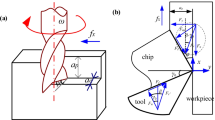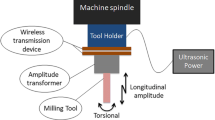Abstract
Considering the lower structural stiffness of titanium alloy thin-walled parts, the machining deformation defects were inevitable. In this paper, the theory and a series of experiments of liquid nitrogen (LN2) cooled titanium alloy milling were executed in details. Based on cantilever sheet, a deflection calculation model of thin-walled parts subjected to milling force load was established considering cooling temperature. Compared with the conventional cooling milling strategy, the effects of LN2 jet impingement on the deformation of milling area were analyzed. The results showed the deformation is related to the milling force, elastic modulus, and the milling point coordinates, and the cooling temperature has an effect on the milling deformation. At cryogenic, the milling force can only be increased by 10% compared with conventional cooling, but nearly 30% for the elastic modulus, as well as following the decreased deflection. At − 130 °C, the brittle chip fracture can be achieved, and the burr phenomenon on the machining surface is improved as well as the machining error. And the deformation of the milling area is decreased significantly. Meanwhile, the high speed milling can reduce the load of the free cutting parts. In addition, LN2 can be achieved full boiling at the large flow of 35.5 L/h, and can quickly reduce the cooling temperature of cutting area and improve the heat transfer efficiency itself. The high milling speed and larger LN2 flow can further improve the deformation defects of thin-walled parts. The cryogenic cooling strategy can change the chip breaking form, reduce the flexural deformation, increase the effective milling speed, and improve the milling system stiffness and the cutting heat transfer efficiency. They are the main reasons for the improvement of the deformation defects in thin-walled parts milling.










Similar content being viewed by others
Data availability
We declare that data sets used or analyzed in the current study can be obtained from corresponding author at reasonable request.
References
Tong JL, Zhang ZP, Chen P (2022) Study on surface morphology of titanium alloy curved thin-walled parts by longitudinal-torsional composite ultrasonic assisted milling. J Manuf Process 84:316–326
Krzystof C, Kazimierz Z (2022) Milling of three types of thin-walled elements made of polymer composite and titanium and aluminum alloys used in the aviation industry. Materials 15(17):5949–5949
Chen PF, Li XF, He XM (2021) Research on force control based on sim2real transfer for stiffness of thin-walled parts. J Mech Eng 57(17):53–63
Abbasi SA, Feng PF, Ma Y, Cai XC, Yu DW, Wu ZJ (2016) Influence of tool inclination angle and cutting direction on long thin-walled parts dimensional and geometric accuracy when high-speed ball end milling the heat-treated titanium alloy Ti–6Al–4V. Proc Inst Mech Eng C J Mech Eng Sci 230(19):2676–2698
Zhang ML, Zhang DY, Liu JJ, Gao D, Han X (2019) Mechanism and experiment of high-speed ultrasonic elliptical vibration milling of thin-walled titanium alloy parts. J Beijing Univ Aeronaut Astronaut 45(8):1606–1612
Jiang XG, Lian HT, Lu HM, Dai JD, Zhang DY (2014) Investigating of ultrasonic elliptical vibration milling of thin-walled titanium alloy parts. Acta Armamentarii 35(11):1891–1897
Pan HL (2016) Deflection prediction and control in milling of thin-wall titanium alloy components. Dissertation, Shandong University
Park KH, Yang GD, Suhaimi MA, Lee DY, Kim TG, Kim DW, Lee SW (2015) The effect of cryogenic cooling and minimum quantity lubrication on end milling of titanium alloy Ti-6Al-4V. J Mech Sci Technol 29:5121–5126
Tahmasebi E, Alaertelli P, Lucchini T, Monno VM (2019) CFD and experimental analysis of the coolant flow in cryogenic milling. Int J Mach Tools Manuf 140:20–33
Wang YQ, Guo DM, Guo LJ, Liu K, Ren F (2020) Research status and development trend of cryogenic machining technology. Aerospace Shanghai 37:11–21
Hong SY, Ding YC (2001) Cooling approaches and cutting temperatures in cryogenic machining of Ti-6Al-4V. Int J Mach Tools Manuf 41(3):1417–1437
Chen C, Zhao W, He N, Li L (2014) Experimental study on high feed milling of TC4 Ti-alloy in liquid nitrogen cooling. Tool Engineering 48(8):13–17
Zhao W (2006) Research on high speed milling mechanism of titanium alloy based on green processing. Dissertation, Nanjing University of Aeronautics & Astronautics
Wang FB, Wang YQ (2019) Investigate on effect of cryogenic cooling on oxidation wear of WC-Co carbide tool milling titanium alloy. Mach Sci Technol 23(6):906–924
Liu HW (2017) Mechanics of materials (Version 6). Higher Education Press, Beijing, pp 10–245
Xu ZL (2006) Elasticity mechanics. Higher Education Press, Beijing, pp 55–232
Ding Y (2016) Introduction to elastic and plastic mechanics. China Water & Power Press, Beijing, pp 121–189
Jiang J, Li YQ, Zhang ZY (1991) Manufacturing technology of titanium alloy parts. National Defence Industry Press, Beijing, pp 25–176
Xu Q (2018) A design of cooling system and cutting experiments for the cryogenic machining of difficult-to-cut materials. Dissertation, Nanjing University of Aeronautics and Astronautics
Wang JY, Ge ZM (1985) Aviation titanium alloy. Shanghai Science and Technology, Shanghai
Zuo JH (2008) Environmental effects on the mechanical performance of Ti-6Al-4V alloy. Dissertation, Institute of metals Research, Chinese Academy of Sciences
Kaynak Y, Gharibi A (2019) Cryogenic machining of titanium Ti-5553 alloy. J Manuf Sci Eng 141(4):041012
Hu L W (2019) Research on the cryogenic cutting machinability and the chip morphology of difficult-to-cut alloys. Dissertation, Dalian University of Technology
She YZ, Jiang YL (2022) Experimental study on heat transfer characteristics of liquid nitrogen spray cooling. J Nanjing Univ Aeronaut Astronaut 54(02):290–296
Song KH, Lim DW, Park JY (2020) Investigation on influence of hybrid nozzle of CryoMQL on tool wear, cutting force, and cutting temperature in milling of titanium alloys. Int J Adv Manuf Technol 10:2093–2103
Varghses V, Ramesh MR, Chakradhar D (2019) Influence of deep cryogenic treatment on performance of cemented carbide (WC-Co) inserts during dry end milling of maraging steel. J Manuf Process 37:242–250
Dhananchezian M, Pradeep KM (2011) Cryogenic turning of the Ti-6Al-4V alloy with modified cutting tool inserts. Cryogenics 51:34–40
BarrnR F, Nellis GF (2016) Cryogenic heat transfer. CRC Press, Raton, pp 20–170
Gordillo JM, Riboux G, Quintero ES (2019) A theory on the spreading of impacting droplets. J Fluid Mech 866:298–315
Zhao K, She YZ, Jiang YL (2019) Numerical study on phase change behavior of liquid nitrogen droplets impinging on solid surface. Acta Physica Sinica 68(24):244401
Funding
This research was partially supported by the natural science foundation project of Liaoning province (no. 2020MS217), the Key Project of Education Department of Liaoning Province (no. LJKZ0237), the National Key R&D Program of China (no. 2019YFB2005400), and the Key Laboratory for Precision/Non-conventional Machining and Micromanufacturing Technology of Ministry of Education, Dalian University of Technology (no. B202001).
Author information
Authors and Affiliations
Contributions
The author focuses on the research on the mechanism and technology of cryogenic cooling machine for difficult-to-machining materials. The process can improve the machining quality, efficiency, and tool life. The research obtains the cooling mechanism of cryogenic coolant. For difficult-to-machining materials, it is a good method to solve the problem of high-efficiency and high-quality machining.
Corresponding author
Ethics declarations
Ethics approval
We declare this research belongs to the field of machining and manufacturing. Only machine tools, alloys, and inorganic liquid nitrogen are employed to be tested and that does not involve any organic life, such as people, animals, and plants. And the issues of life science and ethics research do not also be involved and considered.
Consent to participate
This study was conducted by the corresponding author under the guidance of the professor named Yongqing Wang in Dalian University of Technology. The involved researchers have been listed in the article, and all authors have no objection.
Consent for publication
The authors confirm the work has not been published before, and does not consider other places. Its publication has been approved by all co-authors. The authors agree to publish the article in Springer’s corresponding English-language journal.
Competing interests
The authors declare no competing interests.
Additional information
Publisher's note
Springer Nature remains neutral with regard to jurisdictional claims in published maps and institutional affiliations.
Rights and permissions
Springer Nature or its licensor (e.g. a society or other partner) holds exclusive rights to this article under a publishing agreement with the author(s) or other rightsholder(s); author self-archiving of the accepted manuscript version of this article is solely governed by the terms of such publishing agreement and applicable law.
About this article
Cite this article
Wang, F., Wang, Y. Milling performance of cryogenic cooled titanium alloy thin-walled parts based on cantilever sheet. Int J Adv Manuf Technol 128, 2261–2270 (2023). https://doi.org/10.1007/s00170-023-11987-w
Received:
Accepted:
Published:
Issue Date:
DOI: https://doi.org/10.1007/s00170-023-11987-w




